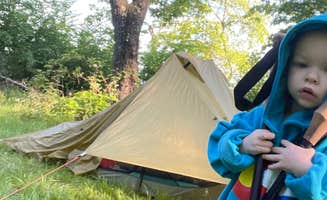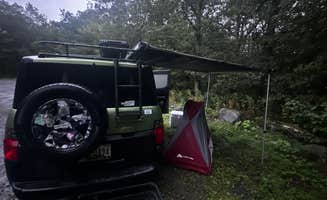Dispersed camping near Pittstown, New Jersey requires advance planning due to limited options in this rural Hunterdon County region. Primitive sites scattered across the Delaware River watershed typically sit at elevations between 400-1200 feet, with summer temperatures averaging 75-85°F. Winter camping remains challenging with frequent sub-freezing nights and minimal facilities available year-round.
What to do
Hiking exploration: Thunder Swamp Trailhead provides access to extensive trail networks for day hiking or overnight backpacking trips. One visitor noted, "Went down Saw Creek trail to a marsh," highlighting the diverse ecological areas accessible from this trailhead. The gravel parking area serves as a convenient basepoint for exploring multiple trail options.
Summit views: Bake Oven Knob offers both overnight camping and rewarding summit views after a short but challenging hike. "The hike to the overlook is really lovely; short and rocky," shares one camper who frequently stays in the area. This high point along the Blue Mountain ridge provides panoramic vistas across the Pennsylvania landscape.
Bird watching: Spring and fall migrations bring diverse bird species through the region's ridges and wetlands. Local conservation areas near primitive camping sites provide seasonal opportunities to observe hawks, warblers, and other migratory birds in their natural habitat.
What campers like
Hammock-friendly terrain: Many sites feature suitable trees for hammock camping as an alternative to tent setups. One camper at Appalachian Trail Designated Backpacker Campsite 2 noted it was "a great place for hammocking" despite being "a little on the small and sloped side for tent camping."
Quiet overnight parking: For those traveling through the region, several trailheads permit vehicle camping. As one visitor to Thunder Swamp Trailhead explained, "Trailhead parking was chill for a night. No trouble." These areas provide basic overnight options without amenities.
Bear safety infrastructure: Some designated backcountry sites include bear protection measures. According to a camper at Appalachian Trail Designated Backpacker Campsite 2, the area is "well maintained with bear boxes provided," an important consideration when camping in black bear territory.
What you should know
Water planning required: Reliable water sources are scarce at most primitive sites. One camper noted about Appalachian Trail Campsite, "There's no water nearby, and the views are only mediocre." Hikers should plan to carry sufficient water or research seasonal water sources before departure.
Parking restrictions: Many access points have specific rules regarding overnight parking. At Bake Oven Knob, "There are two large lots. You can park and sleep, or hike in and find a place for a tent," according to a regular visitor. Always check current regulations as enforcement can change seasonally.
Navigation challenges: Trail markers and campsite identification vary in quality. Several sites are unmarked or minimally marked. Visitors should carry detailed maps and not rely solely on mobile navigation, as cellular coverage remains spotty throughout much of the region.
Tips for camping with families
Shelter alternatives: For families seeking more reliable protection, the Appalachian Trail includes shelters near some campsites. "We had thought there was a shelter (there isn't) but it was fine," notes one hiker at Appalachian Trail Designated Backpacker Campsite 2, highlighting the importance of verifying shelter availability before planning with children.
Space considerations: When camping with multiple family members, site selection becomes crucial. One group camping near Columbia found "plenty of space. We camped nearer to others but there are secluded spots too," providing options for families who prefer either community or privacy.
Emergency planning: Rustic camping near Pittstown, New Jersey requires additional safety preparations for families. With limited cellular service and often considerable distance from emergency services, families should establish communication plans and carry basic first aid supplies appropriate for the activities planned.
Tips from RVers
Parking lot size limits: Thunder Swamp Trailhead accommodates smaller vehicles but has limitations. "It's a gravel parking lot. Plenty of shade. No one bothered me," reports one overnight visitor, but larger RVs may find maneuvering difficult on access roads and in available parking areas.
Seasonal road conditions: Access to primitive camping areas varies significantly with weather conditions. Spring thaws often create muddy, rutted roads unsuitable for larger vehicles or those without adequate clearance. Winter access may require four-wheel drive capability at many sites.
Alternative options: Traditional RV camping near Pittstown requires traveling to established campgrounds, as dispersed options rarely accommodate larger vehicles. Most RVers utilizing primitive sites in this region travel in vans or truck campers rather than conventional recreational vehicles.



